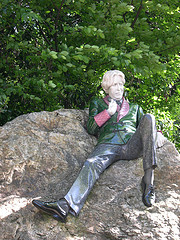1. Are we going together?
Read these examples of Present Continuous:
- So what are you visiting these days then?
- Well, I am visiting the main Dublin attractions first of all and, then, I am celebrating St. Patrick's Day on Thursday.
- I'm trying a true Guinness on Thursday.
- Are we going together?
- Before we go, I'm checking the bus timetables.
The form of the Present Continuous is obviously the same we have studied with the present tenses:
| SUBJECT + TO BE + VERB -ING |
This tense is used to talk about future arrangements. We need a time expression or the appropriate context indicating that it refers to future time.
1. Sarah and John are getting married in a few days.
NEGATIVE: .
INTERROGATIVE: ?
2. Your friend Paul is travelling to Liverpool at the weekend.
NEGATIVE: .
INTERROGATIVE: ?
Practice the Present Continuous for future arrangements by doing these exercises:
| Exercise 1 |
Exercise 2 |
Do these sentences in the Present Continuous form refer to present or future time?
1. Peter is seeing his mother on Tuesday.
 |
| By Hélder Cotrim, C. Commons |
a) present | |
b) future | |
2. What are you doing with that computer? You must do your homework first!
a) present | |
b) future | |
3. When is your brother returning from Africa?
a) present | |
b) future | |
4. Where are you staying when you go to Dublin?
a) present | |
b) future | |
5. What is he studying at the moment?
a) present | |
b) future | |
Let's remember the different ways to express future time that we have learned in this unit so far:
- WILL: a promise, an offer, a prediction based on opinion, a decision made at the moment of speaking.
- BE GOING TO: a plan or intention, a prediction based on what is happening.
- PRESENT CONTINUOUS: future arrangements.